The pursuit of discovery is a common thread among both artists and scientists. To solve, or maybe at this point, to mitigate the challenges we face, an ongoing dialogue is vital between the two fields, one that includes the voices of the underrepresented. Approaching planetary change with a “working with nature” attitude rather than a hierarchal “everything is a potential resource” way of thinking is a necessity, and this requires a shift in our consumer/global capital mindset.
As an artist, researcher, and educator, I see a responsibility for critical reflection; questioning my material choices, my pedagogical approach, and providing a call to action, as well as a celebration of resilience in the face of our struggles. Increased interdisciplinary engagement between the arts and sciences reveals that the boundaries between the two are often diffuse, revealing overlaps in methodological impulses and challenging our assumptions about the lines we have drawn between the two. I refer to my work, as a practicing artist, as coordinator for a graduate art program, and as a researcher, as “Radical Gardening”- acts of stewardship, caretaking, and social responsibility.
For a class on textile, along with developing skills in process, I presented research centered on the life cycle of textiles, the exploitation of labor in the textile industry, and the effects of these practices on our soil and water. The final project asked for creating a “performative wearable” and documentation.
As an example from my own work, “Tactical Forage Vest” uses recycled drop cloths to create a functional piece that is worn to gather soil and water, and botanical samples during recent research fieldwork at sites of PFAS contamination.I was influenced by the Post Carbon Institute and Richard Heinberg, speaking about the notion of a shift to reliance on local sources for consumer goods. The irony for me is that the local economy is based on a dying industry- forestry. I am collaborating with my students and scientists at the university to investigate bioproducts from the forests, but the image, taken in my town, puts ideas of sustainability into question.
Also pictured here is the work of Jenna Davenport, “Buzz Fuzz,” which allowed us to look at the plight of pollinators using a pair of crocheted blooming chaps that can be worn on field walks; a powerful symbolic gesture to remind us of our role in more than human multi-species survival. An artwork such as this can be an effective way to present issues and remind us there is a possibility of solutions if we all get on board.
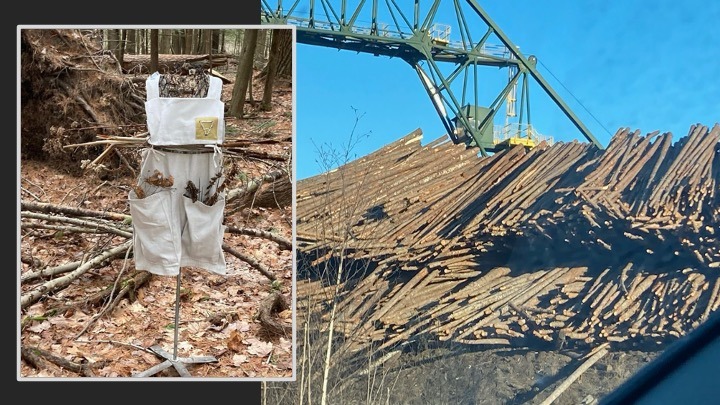
Susan Smith
Tactical Forage Vest
2023, lumber mill, Dover Foxcroft, Maine, US.
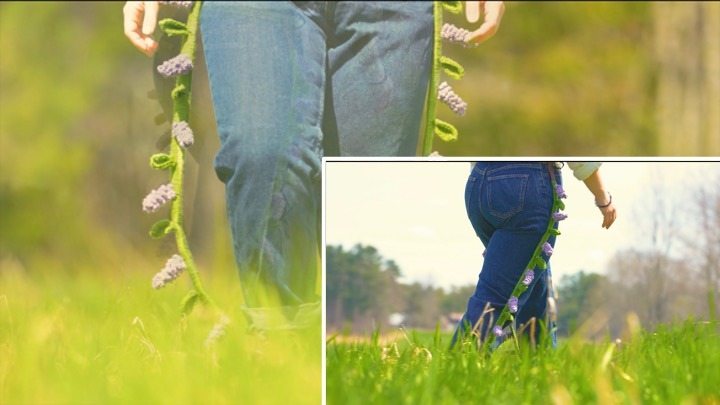
Jenna Davenport
Buzz Fuzz
2023, video still
Interdisciplinary collaboration is the core of where I see the future of academic work, as well as the potential for artistic practice. With the intention to look toward possible solutions for the environmental crisis, graduate students in environmental engineering and fine arts at the University of Maine worked together in the classroom, studios, and laboratory, looking at PFAS contamination. The culmination of this work was an exhibition, which in many ways was secondary to the experience of shared knowledge, conversation, and discovery that is inherent in both disciplines.
To model this path of collaboration, the environmental engineering professor, Onur Apul, and I met over the course of the spring to share knowledge and ideas. Water and soil from forever chemical contaminated rivers were mixed with pigments from soil and construction detritus to become the materials used in painting, and soil health profiles were another aspect of my work, using the process of “soil chromatography.”
Students in the class conducted research and brought a wide array of works to the exhibition. Art and music student Ruixin Niu, student composer Benjamin Walker and engineering student Kenneth Mensah created a performance that involved a 3D printed violin, a score composed using images/sounds of nanotechnology, and spoken word about water research.
Another group, Luke McKinney and Casey Schatzabel produced a citizen science cookbook inviting participants to conduct their own experiments and, in essence, be the authors of potential solutions to water health.
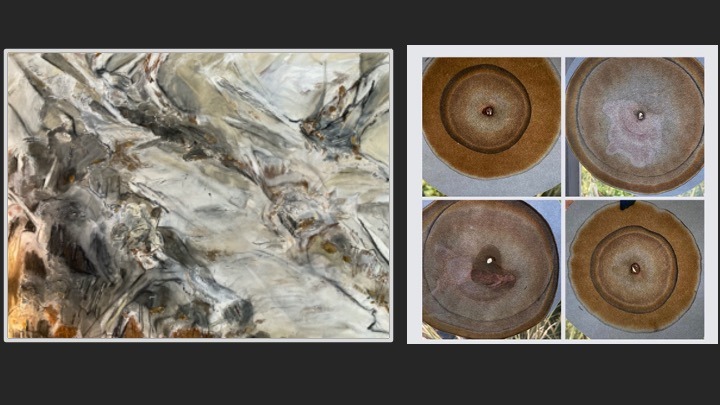
Susan Smith
From the river 2023
Soil (from fracking, carpet, and Teflon manufacturing sites), water (Oostanaula River, Kennebec River), charred wood, cement (Flat Rock, North Carolina (US) excavation site)
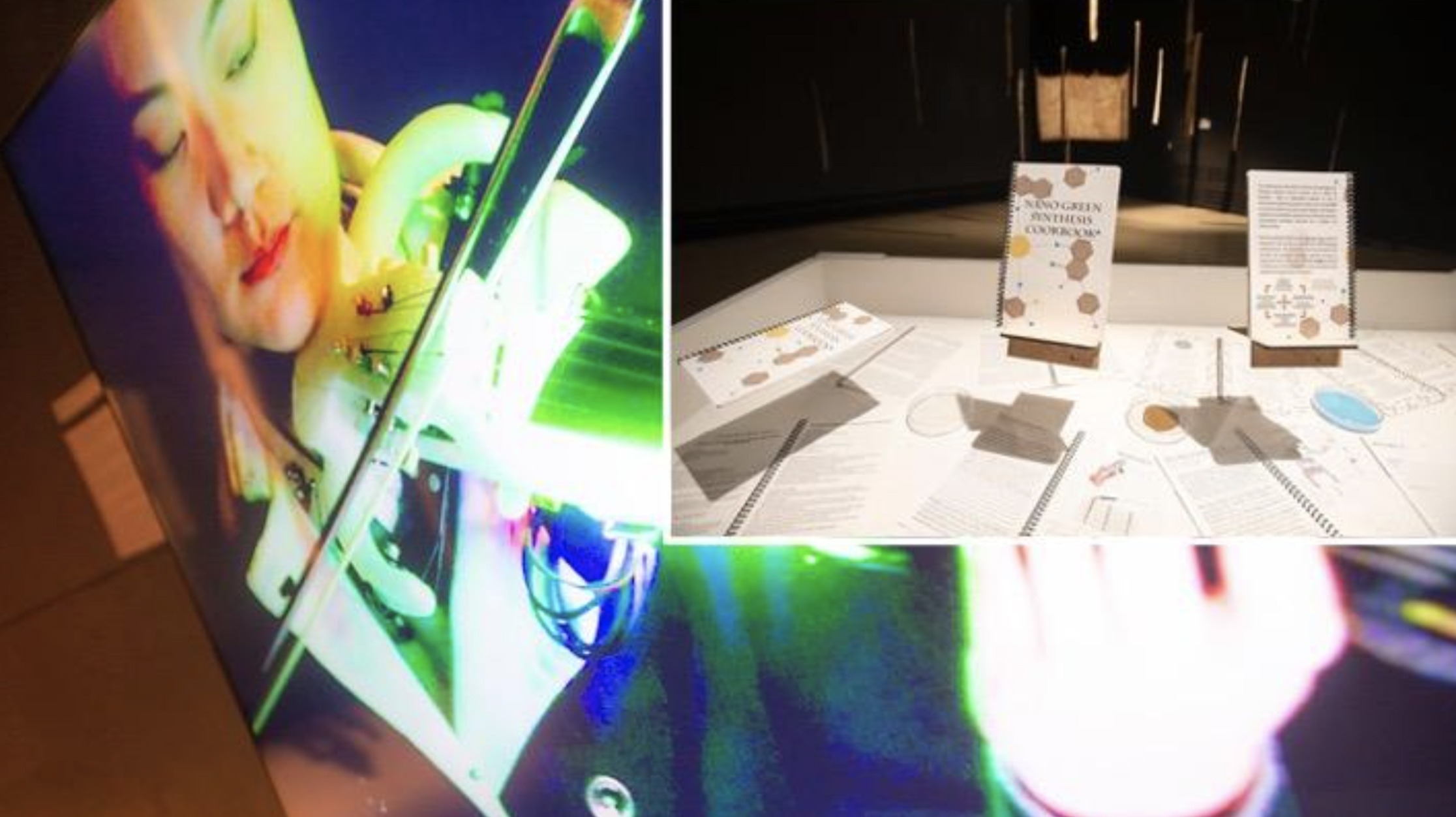
Left: Ruixin Niu, Kenneth Mensah, Benjamin Walker, and Dr. Onur Apul
Ode to Nanobubble 2023
Performance, video, laser cut plywood
Right: Casey Schatzabel, Luke McKinney
Nano Green Synthesis Cookbook 2023
38-page citizen scientist’s field guide
Art is crucial in helping us understand principles of scientific discovery, and science is well served by being seen through an artistic lens. SLAB (StudioLab) is an ongoing collaboration between graduate art and forest resource students. As forestry has historically been one of the key drivers of the Maine economy, this mobile unit creates an interactive site for creative activity and exploration of Maine forests and the development of a web-based learning tool. The SLAB houses a specimen library, interactive technology featuring research forests throughout the state, photo, and video-based content, and an invitation to participate in citizen science delivering scientific data directly to the public, encouraging the sound long-term management of Maine’s forest resources and eco-tourism industry.
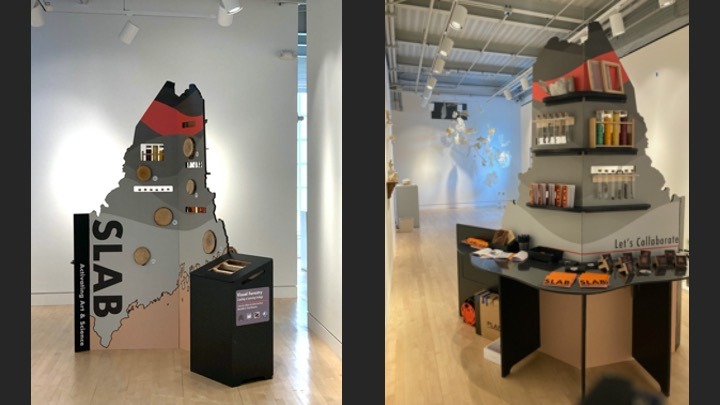
StudioLab: Visual Forestry, Creating a Learning Ecology 2022-2023
University of Maine, Intermedia MFA, IPhD, and School of Forest Resources
Whether visual, spatial, graphical, or interactive, the arts help foster modes of problem-solving and communication. Beyond the use of art simply to document scientific progress, artists themselves are daily conducting research in methods and materials that produce new processes and ways of considering precious resources in a time of environmental challenge.
While the arts can be leveraged to impact scientific learning, enabling viewers to explore concepts from multiple vantage points, they use distinct modalities of learning and incorporate emotional responses.
The projects described here: collaborations between sustainable forestry, environmental engineering, climate change, intermedia art, and forest bioproducts, are not just an occasion for education of the layperson but, in addition, afford a dialectic between art and science.
A blend of the fields of art and science does not represent a schism. Instead, it offers possibilities and solutions that cannot be accessed by treating each field as a separate, always distinct domain.
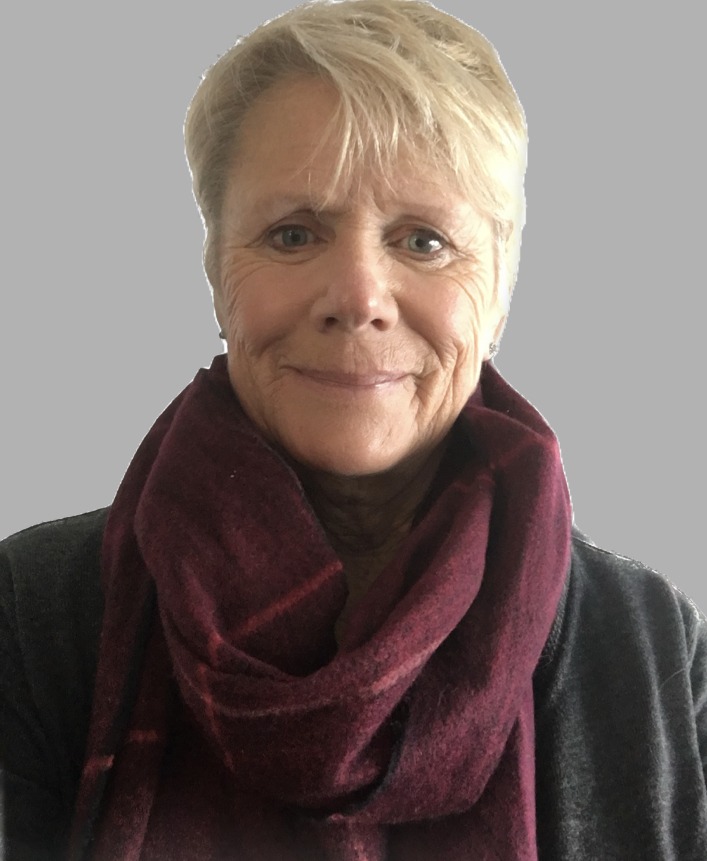 Dr. Susan L Smith, is a practicing artist and educator, Associate Research Professor of Art, and Graduate Coordinator of the Intermedia Programs at the University of Maine. Smith’s research is situated within issues of land/power and questions concerning extractivist practices, economic and climate-forced migration.
Dr. Susan L Smith, is a practicing artist and educator, Associate Research Professor of Art, and Graduate Coordinator of the Intermedia Programs at the University of Maine. Smith’s research is situated within issues of land/power and questions concerning extractivist practices, economic and climate-forced migration.
Her practice encompasses community-based collaboration, and site-based research. Recent work centers on the struggle of asylum seekers on the US southern border, and Smith is a recipient of a juror’s award from the International Surface Design Exhibition for works addressing
immigration, produced in textile and sculpture, a 2020 participant in the Center for Maine Contemporary Art Biennial, and currently exhibiting in the multi-location international exhibition “Crossing Borders.” Recent publications include The Indian Quarterly, A Theology of Practice-Based Research, and Surface Design Journal. Smith believes the physical work is not the art, but an “artifact,” the art lies in the process of immersion and witness of place and community.
Susan is currently working with the Urban Soil Institute, NYC, to create works that focus on stewardship and interdependency as a way to radically imagine a sustainable future.
This article is a contribution to the “The Arts and the Anthropocene” series by the MAHB Arts Community. If you’re an artist passionate about sharing your insights and artwork on this subject, please don’t hesitate to reach out to Michele Guieu, Eco-Artist and MAHB Art Director, at michele@mahbonline.org. Your contributions are greatly appreciated.
Thank you. ~
